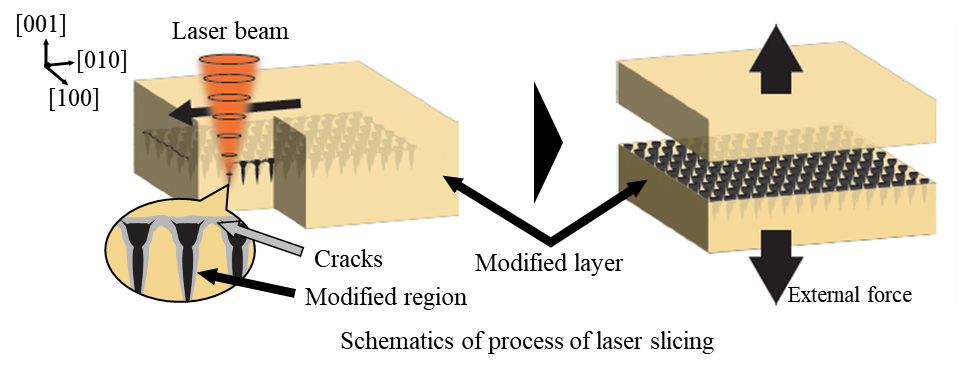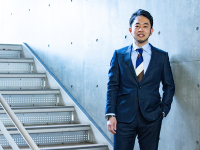The new technique uses laser pulses to slice diamond into thin wafers, paving the way for its adoption as a next-generation semiconductor material
Diamonds are promising materials for the semiconductor industry, but slicing them into thin wafers is challenging. In a recent study, a research team from Chiba University developed a novel laser-based technique for effortlessly slicing diamonds along the optimal crystallographic plane. Their findings will help make diamonds cost-effective semiconductors for highly efficient power conversion in electric vehicles and for high-speed communication technologies.

Image title: Slicing diamonds with laser pulses
Image caption: Focusing the energy of a laser beam into a small volume of a diamond sample creates tiny ‘modified regions.’ If these modified regions are laid out in a precise grid-like pattern, the ensuing cracks make it easy to separate a {100} wafer from the diamond.
Image credit: Hirofumi Hidai from Chiba University
Image license: Original content
Silicon-based materials are currently the undisputed leaders in the field of semiconductors. Even so, scientists around the world are actively trying to find superior alternatives for next-generation electronics and high-power systems. Interestingly, diamonds are among the most promising materials for applications such as fast telecommunications and power conversion in electric vehicles and power plants.
Despite their attractive properties for the semiconductor industry, the applications of diamonds are limited due to the lack of techniques to slice them into thin wafers efficiently. As a result, diamond wafers must be synthesized one by one, making fabrication costs prohibitive for most industries.
Now, a research team from Japan, led by Professor Hirofumi Hidai from the Graduate School of Engineering at Chiba University, has found a solution to this problem. In a recent study, made available online on May 18, 2023, and published in Diamond & Related Materials in June 2023, they report a novel laser-based slicing technique that can be used to cleanly slice a diamond along the optimal crystallographic plane, thus producing smooth wafers. Their study is co-authored by master’s student Kosuke Sakamoto from the Graduate School of Science and Engineering at Chiba University and former Ph.D. student Daijiro Tokunaga, currently an Assistant Professor at Tokyo Institute of Technology.
The properties of most crystals, including diamonds, vary along different crystallographic planes—imaginary surfaces containing the atoms comprising the crystal. For instance, a diamond can be easily sliced along the {111} surface. However, slicing {100} is challenging because it also produces cracks along the {111} cleavage plane, increasing kerf loss.
To prevent the propagation of these undesirable cracks, the researchers developed a diamond processing technique that focuses short laser pulses onto a narrow cone-like volume within the material. “Concentrated laser illumination transforms diamond into amorphous carbon, whose density is lower than that of diamond. Hence, regions modified by laser pulses undergo a reduction in density and crack formation,” explains Prof. Hidai.
By shining these laser pulses onto the transparent diamond sample in a square grid pattern, the researchers created a grid of small crack-prone regions inside the material. If the space between the modified regions in the grid and the number of laser pulses used per region are optimal, all modified regions connect to each other through small cracks that preferentially propagate along the {100} plane. Consequently, a smooth wafer with {100} surface can be easily separated from the rest of the block by simply pushing a sharp tungsten needle against the side of the sample.
Overall, the proposed technique is a pivotal step toward making diamonds a suitable semiconductor material for future technologies. In this regard, Prof. Hidai remarks: “Diamond slicing enables the production of high-quality wafers at low cost and is indispensable to fabricate diamond semiconductor devices. Therefore, this research brings us closer to realizing diamond semiconductors for various applications in our society, such as improving the power conversion ratio in electric vehicles and trains.”
Let us hope that this coveted crystal gives us an edge in our quest for advanced technological development, including those that can ensure a more sustainable future!
About Professor Hirofumi Hidai
Hirofumi Hidai obtained his doctoral degree from Tokyo Institute of Technology in 2004. He joined Chiba University in 2010, where he currently holds the title of Full Professor at the Department of Mechanical Engineering. His research interests lie mainly in advanced manufacturing technologies, including precision machining and laser-based processing. He has published over 100 papers on these topics and holds three patents. He is also a member of the Laser Society of Japan, the Japan Society of Applied Physics, and the Japan Society for Precision Engineering, among others.
Reference:
Title of original paper: Laser slicing of a diamond at the {100} plane using an irradiation sequence that restricts crack propagation along the {111} plane
Authors: Kosuke Sakamoto1, Daijiro Tokunaga1, Sho Itoh1, Hirofumi Hidai1,2, Souta Matsusaka1, Takashige Omatsu2, Koji Koyama3, Seong-Woo Kim3, and Noboru Morita1
Affiliations:
- Department of Mechanical Engineering, Chiba University, Japan
- Molecular Chirality Research Center, Chiba University, Japan
- Orbray Co., Ltd., Tokyo, Japan
DOI: 10.1016/j.diamond.2023.110045
Contact: Hirofumi Hidai
Graduate School of Engineering, Chiba University
Email: hidai@faculty.chiba-u.jp
Public Relations Office, Chiba University
Address: 1-33 Yayoicho, Inage, Chiba 263-8522, Japan
Email: koho-press@chiba-u.jp
Recommend
-

The joy of revealing the unknown: The challenge of solving the mystery of the Sun
2022.09.28
-

Non-Injectable Mucosal Vaccines Providing Safe and Less Stressful Immunization
2022.07.26
-

What causes nations and regions to perceive the COVID-19 crisis differently?〜Insights from the Humanities and Social Sciences Needed for Disaster Management Research
2022.12.12

